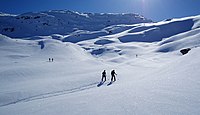
Photo from wikipedia
Abstract The aims of this study were to compare performance with physiological and perceptual responses on steep uphill inclines between double poling and diagonal stride and to investigate the effects… Click to show full abstract
Abstract The aims of this study were to compare performance with physiological and perceptual responses on steep uphill inclines between double poling and diagonal stride and to investigate the effects of pole length when double poling. Eight male, competitive cross-country skiers (22 ± 1.1 yrs, peak oxygen uptake (VO2peak) in the diagonal stride: 69.4 ± 5.5 ml·kg-1·min-1) performed four identical tests, one in the diagonal stride, and three in double poling with different pole lengths (self-selected, self-selected -5 cm and self-selected +10 cm). Each test was conducted at a fixed speed (10 km/h), with inclination rising by 1%, starting with 7%, each until voluntary exhaustion. VO2peak, the heart rate, blood lactate concentration, and the rating of perceived exertion were determined for each pole length in each test. The peak heart rate (p < 0.001) and VO2peak (p = 0.004) were significantly higher in the diagonal stride test compared with double poling with all pole lengths. Time to exhaustion (TTE) differed significantly between all four conditions (all p < 0.001), with the following order from the shortest to the longest TTE: short poles, normal poles and long poles in double poling, and the diagonal stride. Consequently, a significantly higher slope inclination was reached (p < 0.001) using the diagonal stride (17%) than for double poling with long poles (14%), normal (13%) and short (13%) poles. The current study showed better performance and higher VO2peak in the diagonal stride compared to double poling in steep uphill terrain, demonstrating the superiority of the diagonal stride for uphill skiing. However, in double poling, skiers achieved improved performance due to greater skiing efficiency when using long poles, compared to normal and short poles.
Journal Title: Journal of Human Kinetics
Year Published: 2021
Link to full text (if available)
Share on Social Media: Sign Up to like & get
recommendations!